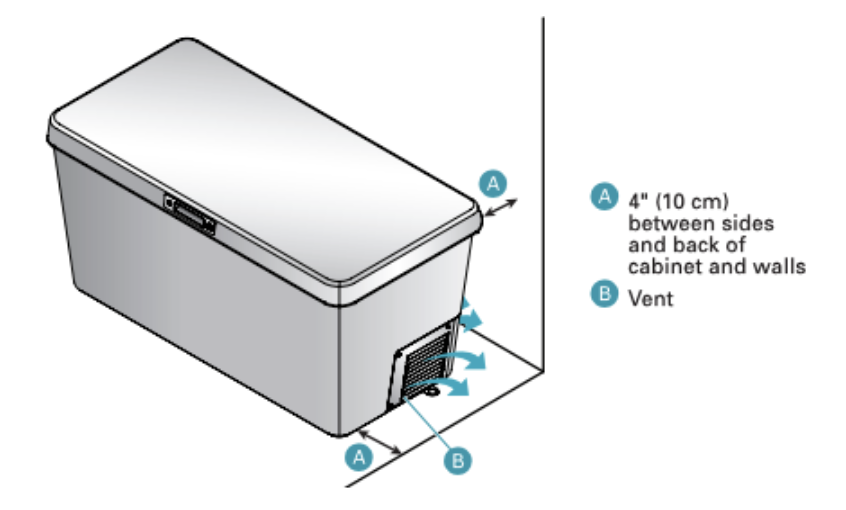Choosing the best place to install your HomeValet powered Smart Box
If you’re thinking about ordering a Smart Box, chances are you’re also considering where you’d like to set it up once it arrives.
While you may be tempted to focus on aesthetics and curb appeal when picking out a location, it’s important to keep in mind the three things that are required for optimum Smart Box performance:

- A firm, level surface with adequate air circulation
- A GFCI-protected electrical outlet
- A strong WiFi signal
In this post, we’re going to dive into these requirements to help you choose a spot that will keep your Smart Box running safely and efficiently.
Physical Location
The most important things to think about when setting up a Smart Box are the unit’s physical requirements to operate.
Below we tackle the two primary factors that you should consider: surface grade and air circulation.

Choose a firm, level surface
Place your Smart Box on a level surface that is strong enough to support the unit when fully loaded with groceries and packages, such as a front porch or patio.
If those locations aren’t options for you, placing the box on grass or in the landscaping surrounding your house can be good alternatives. Set the Smart Box’s legs on pavers, bricks, or stones to ensure an even grade when going this route.
Note: When placing a Smart Box on grass or in landscaping, make sure that it isn’t in the path of sprinklers or other types of irrigation; water in the vents can damage the Smart Box’s motor.

Ensure adequate air circulation
A Smart Box needs about 4” of clearance to provide proper air circulation. Check that you can pull the unit away from walls or other structures and that the air vents aren’t likely to become obscured by leaves or yard debris.
Other considerations
Weather
While the Smart Box should function well in most weather conditions, placing the Smart Box in a shaded location will help with energy efficiency in hot weather and provide water protection during periods of rain or snow.
Visibility
Avoid placing your Smart Box in your garage, in a side or back yard, or in places that aren’t readily accessible. Instead, focus on placement near your front door or in another spot that’s highly visible when someone approaches your home.
Remember, a delivery driver can’t deliver to your Smart Box if they can’t find it, so do your best to make it easy for them!

Power Source Requirements
In general, your Smart Box doesn’t require anything special when it comes to power. In fact, it only has one requirement which you may not be familiar with by name: a GFCI-protected outlet.
What is a GFCI?
A Ground Fault Circuit Interrupter (GFCI) can help prevent physical harm by cutting power if it senses an interruption in the current. GFCI-protected outlets are extremely common and can typically be found in locations where power is used near a water source, such as a bathroom, kitchen, or outdoors.
As a safety precaution, all Smart Boxes require a 115V GFCI-protected outlet for operation.
In newer homes, most outdoor outlets come equipped with GFCI protection; however, if your outdoor outlets don’t, there’s no need to panic.
A certified, licensed electrician can easily convert any existing outlet to a GFCI-protected version for less than $200. If you happen to be handy, then it’s possible to complete the job yourself for just the price of parts.
Other considerations
We also discourage the use of adapters, extension cords, or outlets that you can turn off by a switch or pull chain for safety purposes.
WiFi Requirements
Your Smart Box requires a strong WiFi signal to communicate with the HomeValet platform.
Before your Smart Box arrives, it’s a good idea to test the WiFi signal in the area where you plan to install your Smart Box.
Testing your signal strength
The most basic way of testing your network’s signal strength is to take a look at how many bars your WiFi network shows when you attempt to access it via your phone or computer.
However, counting the number of bars will only give you a general idea of signal strength. Given the importance of connectivity when using your Smart Box, it’s better to get a more exact measurement.

WiFi strength is often measured using the unit ‘decibels relative to milliwatts,’ or dBm.
The dBm measurement can be a little confusing as it is expressed in negative numbers. The scale runs from -30 to -90 dBm, with -30 being the maximum WiFi signal strength possible.
Signal strength anywhere between -30 and -60 dBm should be sufficient for use with your Smart Box.
We recommend taking your phone, tablet, or laptop to the area where you want to install your Smart Box to determine your WiFi network’s dBm at that location.
If you’re ready to verify your WiFi network’s signal strength, we have a ‘How to’ that covers the process on all major platforms.
Click here to check it out.
What to do if you have a weak WiFi signal?
If the WiFi signal in your desired Smart Box location isn’t as strong as you would like, there are a couple of things you can do to help:
- Move your WiFi router – Try shifting the router closer to the area where your Smart Box will be, arranging the router, so there are as few obstacles (walls, furniture, etc.) between it and the Smart Box location as possible.
- Get a WiFi extender – If moving your router isn’t a possibility, look into getting a dual-band WiFi extender.
While they vary in price, most are relatively inexpensive (like this one) and are sold at retailers such as Walmart, BestBuy, and Amazon.
Still have questions?
If you have questions about Smart Box location requirements, be sure to visit our Help Center for answers to FAQs, or feel free to reach out to our Customer Support team for 1:1 assistance.
